
Photo: Gilbert Keith-Agaran
The MAYOR F. CRAVALHO WAY
Alfredo G. Evangelista | Assistant Editor
When Mayor Elmer F. Cravalho passed in 2016, written tributes spoke of his many public accomplishments. Speaker of the Territorial and State House. First Mayor of Maui. Business leader. Board and commission member. While Cravalho could be aptly described as dedicated, politically astute, powerful and generous (Retired Circuit Court Judge Artemio Baxa spoke of Cravalho’s “generous compassion for the weak, the poor and the underprivileged”), Cravalho undoubtedly was visionary. Many longtime residents believe, however, there will never be enough said or done to sufficiently give credit for Mayor Cravalho’s service to the State of Hawai‘i and the County of Maui.

Photo: Gilbert Keith-Agaran
On June 30, Governor David Ige quietly and without any fanfare signed into law as Act 134, S.B. 651, S.D. 1, H.D. The bill, introduced by State Senator Gilbert S.C. Keith-Agaran (D-Central Maui) and co-sponsored by Senators J. Kalani English (D-E. Maui, Upcountry, Molokai, Lana‘i), Lorraine Inouye (D-Honoka‘a), and Chris Lee (D-Lanikai-Waimanalo), renamed the Kahului Airport Access Road to the Mayor Elmer F. Cravalho Way. An identical or companion House Bill 774 was sponsored by Rep. Kyle Yamashita (D-Upcountry), Lynn DeCoite (D-East Maui, Molokai, Lana‘i), Troy Hashimoto (D-Wailuku), Angus McKelvey (D-West Maui) and Justin Woodson (D-Kahului).
“Any Maui legislator would be happy to introduce proposals on behalf of constituents,” said Keith-Agaran. He described that Pat Constantino and others noted there was no memorial for Mayor Cravalho.
“While I realize the Mayor could be a private man in many ways,” Keith Agaran explained, “he was undoubtedly a significant State public official, and likely the most significant Maui political figure and community leader of the latter half of the 20th Century and deserving of much recognition.”
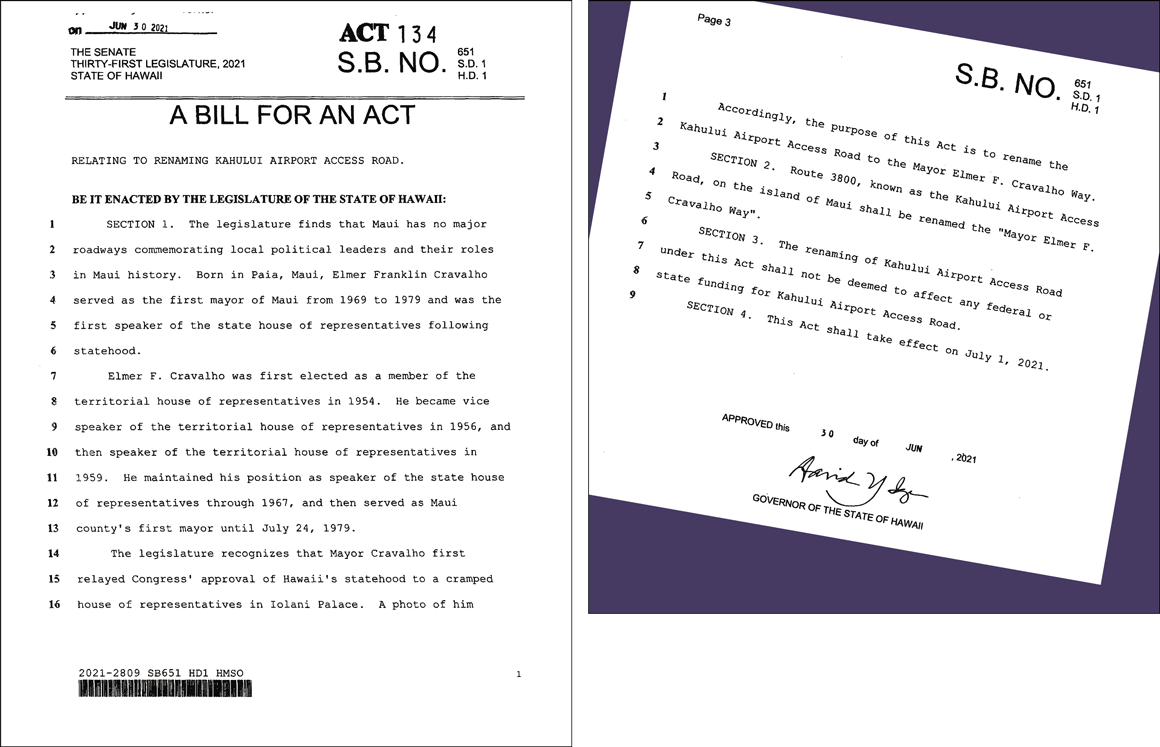
At press time, the State Department of Transportation has not publicly announced when the actual change will be done. (The Department of Transportation initially testified it favored a non-binding resolution instead of a bill.) When Mokulele Highway was renamed Maui Veterans Highway in 2017, four months passed before the actual signs were installed.
When the transition from Airport Access Road to Mayor Elmer F. Cravalho Way does finally occur, it will be a small recognition of Cravalho’s unfaltering dedication to the people of the State of Hawai‘i, especially Maui County.
In the latter half of the 20th Century, Cravalho was one of the towering figures as Hawai‘i moved from a Territory to a full-member of the American union. Inside Kahului airport is the Hawaiian Airlines mural containing the iconic photo of Speaker of the House Cravalho taking the call from Hawai‘i Delegate to Congress John A. Burns who informed Cravalho and members of the Territorial Legislature that Congress had just approved statehood for Hawai‘i.
After Burns became Governor in 1962, Burns would speak of his vision for the 50th State. But as political writer Dan Tuttle would later claim in his oral history, it was Cravalho who created and pushed through the legislative details of Burns’ plans: “He deserves his place in history. He’s a giant. He contributed a great deal to Burns’ career. He supplied the New Hawai‘i Program for Jack Burns. When Jack Burns’ administration, ’63, ’64, ’65 period, was faltering, Elmer stepped in with a legislative program. Jack Burns would get up and address the Legislature in his State of the State address, talk only about destiny and dreams, but have nothing practical.”
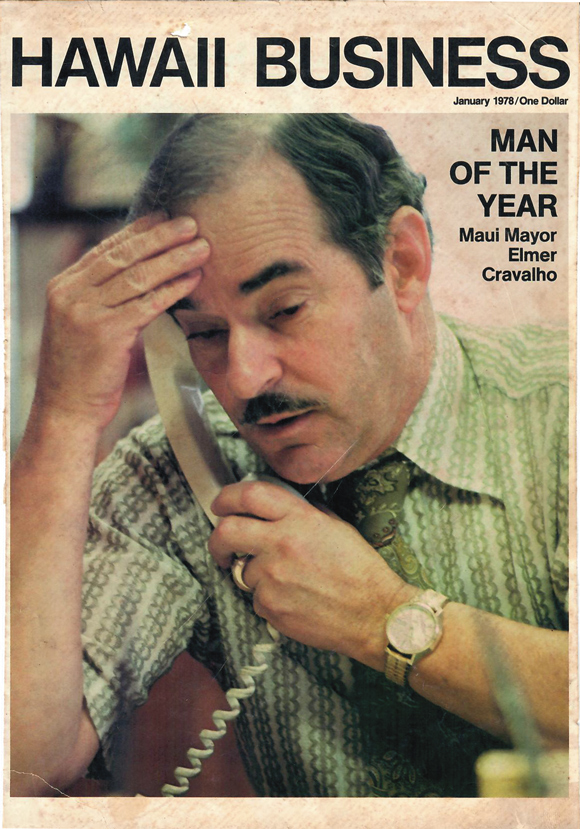
Image courtesy Cravalho Ohana
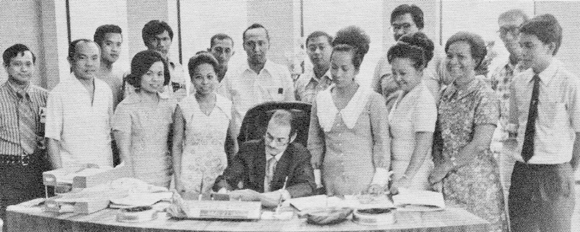
Photo courtesy Maui Filipino Community Council
Constantino, one of Cravalho’s political deputies, agrees. “I remember the biggest plans were to work together with the Big Five to develop Hawai‘i’s economy. One early morning, Cravalho had me accompany him to Washington Place where Burns lived—just the three of us—talking story about how to do certain things.”
Constantino, who was seen by many as Cravalho’s man in the Filipino community, served as an Assistant Sergeant of Arms. (Another Maui Filipino stalwart Pepito Ragasa previously served as Cravalho’s Assistant Sergeant of Arms.) Constantino initially met Cravalho at the A&B Super Market in Kahului (where the Central Pacific Bank in Kahului is now). Constantino was employed as a stock and delivery boy while attending Maui Technical School. Cravalho chatted with Constantino about his studies (Business Accounting) and Constantino mentioned he needed a job. Constantino lost his Dad after high school and needed to take care of his mother and sister, and his wife Cora was expecting their second child. Cravalho hired Constantino as an account clerk with MDG Supply, Inc. and later brought Constantino to work one session at the Legislature. Constantino subsequently became the office manager at Kula Community Federal Credit Union where Cravalho was the treasurer. Constantino joined the Maui Democratic Party and was elected to attend the 1968 Democratic Party National Convention in Chicago. “I was the youngest delegate from Hawai‘i and the first Filipino to attend at age twenty-five,” says Constantino who led the Council of Political Associates (COPA) for many years.
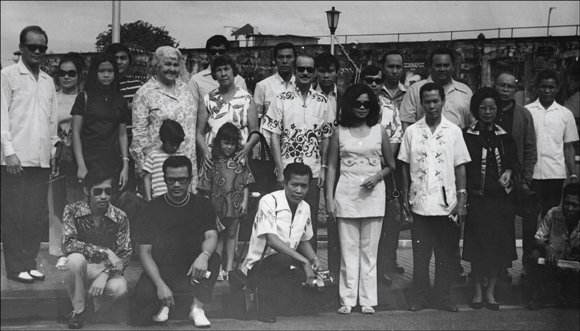
Photo courtesy Patrick Constantino

Photo courtesy Patrick Constantino
Constantino was at Cravalho’s side for a significant part of Cravalho’s tenure as Mayor—first as Executive Assistant, then as County Treasurer and later as Country Grant Administrator and Risk Manager. Constantino was even part of the group that accompanied Cravalho to the Philippines in 1971. “Maui is what it is today by the beginnings of Mayor Elmer F. Cravalho’s thoughts and ideas. It’s an honor to have known him in this lifetime. If he could give a degree on life, I would have received a Doctor’s degree for the knowledge I gained by knowing and learning from him. But above all, he has been a father image and part of my family.”
On December 13, 1966, Eddie Tam, the Chairman of Maui’s Board of Supervisors unexpectedly died after being elected to another two-year term as Chairman. The remaining supervisors appointed Manuel Molina to fill the unexpired term of Tam but there was a question whether Molina could be appointed to Tam’s new term as there was no legal provision governing the situation. (Molina even refused to be sworn in as a Supervisor.) The Legislature passed a bill calling for a special primary and general election and Burns signed it into law. But Supervisor Joseph Bulgo, Molina’s nephew, sued to stop the special election and to prevent Cravalho from appearing on the ballot. Bulgo was granted an injunction by the trial court but despite Bulgo being represented by future Supreme Court of Hawai‘i Associate Justice Frank Padgett, Bulgo lost both cases before the high court and the special elections proceeded.
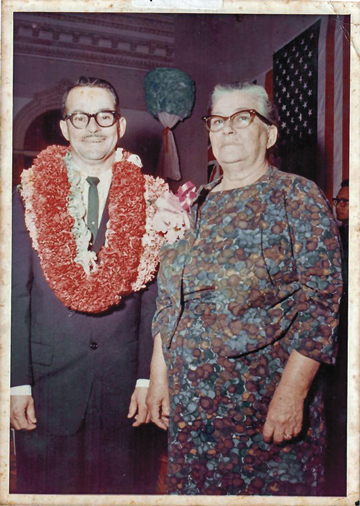
Photo courtesy Cravalho Ohana

Photo courtesy Cravalho Ohana
Constantino and others campaigned hard for Cravalho. At one point on election night, he recalls Cravalho was behind some 500 votes and the campaign was losing hope. “He asked us what precincts didn’t come in. We said Lāna‘i, Molokai, Ke‘anae, Hāna, Kaupō and ‘Ulupalakua. He took a tablet and wrote some numbers down and said ‘Go eat you guys; it’s all over. We’re in by 133 votes!’ ” recalls Constantino. “Of course, none of us had the appetite to eat.” Cravalho proved his ability to count votes and squeaked by Molina—beating him by 139 votes.
It was during the 1967 campaign that twenty-year-old Roger Cachola first met Cravalho. Cachola, a Narvacan, Ilocos Sur native, arrived on Maui on March 8, 1967. He was one of the wave of Filipinos who arrived as a result of the Immigration and Nationality Act of 1965 signed by then President Lyndon Johnson. It would be the start of post-Sakada migration in the late 1960s. While Cachola studied Accounting at Far Eastern University, he could only find a job as a tray boy at Maui Pineapple. After work, Cachola met Cravalho passing out his brochures.
“I can’t help you because I can’t vote,” Cachola recalls telling Cravalho. “I’m just a new immigrant.” Cachola and others were active in the Filipino Cultural Club; Cachola remembers dancing Tinikling at the Kahului Shopping Center. Cachola recalls how Cravalho was involved in the Filipino community’s social events—attending many parties hosted by Maui’s growing Filipino community.
In 1968, Baxa, Cachola, and Phil Domingo—all recent immigrants—were hired as the first Filipino immigrants to work at the County under what was called a Work Experience Program and they were assigned to Cravalho’s office. Because the Board of Supervisors did not approve the program, Cravalho personally paid for the salaries of Baxa, Cachola and Domingo. It would be a couple of years before the County Council agreed to fund the Work Experience Program. Baxa and Cachola began collecting data on immigrants and eventually started the Office of Immigrant Services that was administered through the Mayor’s office.
During this time of growing immigration, there were a lot of activities affecting Maui’s Filipino community—and Cravalho had a hand—directly and indirectly in many of them.
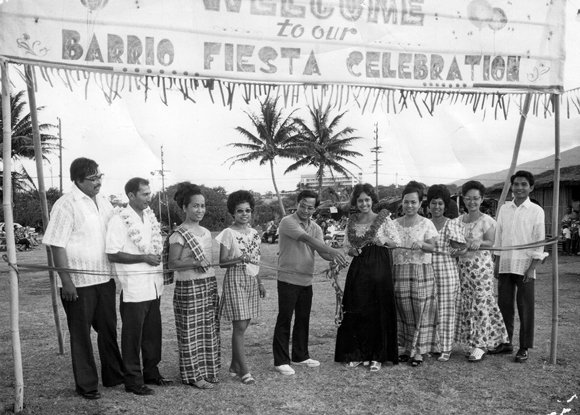
Photo courtesy Patrick Constantino
The Maui Filipino Community Council held its first Barrio Fiesta on May 31, 1970—as part of the Maui Filipino Community Council’s first Fiesta Filipina encompassing three months of cultural activities. The Fiesta Filipina’s General Co-Chairpersons were the late Raquel “Nancy” Andres and the late Fred Duldulao while the president of the Maui Filipino Community Council was the late Paul Pladera. “It was Nancy’s idea to start the Barrio Fiesta. She developed the concept and because she was new on Maui, she worked through some old-timers to get it done,” said the late Agrifina Cabebe, who would serve as the Barrio Fiesta’s first chairperson with Greg Peros as her co-chairperson.
“Manang Nancy wanted to spread the Filipino culture. She was the brains behind the Barrio Fiesta and asked me to be part of it,” said Peros. “I was fresh out of the U.S. Army and I wanted to contribute to the Filipino community, which was at a crossroads with the influx of many immigrants from the Philippines. We wanted to share our rich culture with everyone, including the local Filipinos.”
The goal of bringing Philippine culture and portraying Philippine life through traditional dances, enchanting music, and a festive atmosphere was accomplished. As Andres said “For truly Hawai‘i, as the melting pot, is composed of many cultures and Filipinos here in Maui should all be proud to give their contribution to the fullest extent.”
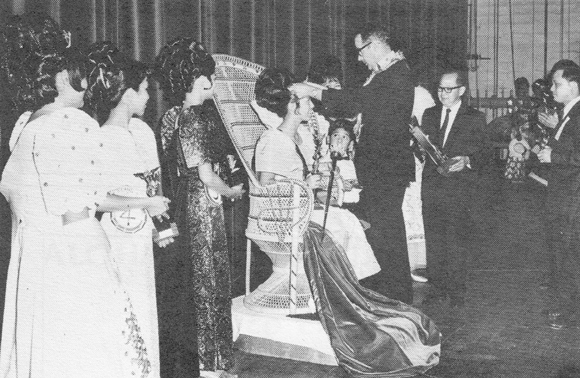
Photo courtesy Maui Filipino Community Council
Cravalho gladly issued a Proclamation to mark Maui’s Fiesta Filipina and the leaders of the Maui Filipino Community Council gladly posed for a photo op with the Mayor.
In addition to sharing the culture, there was a need for assistance to newly-arrived students from the Philippines. “He wanted us Filipino professionals to help the immigrant kids especially the Filipino kids,” said Shirley Evangelista. “When I came home in 1968, I couldn’t find a job so Dr. Alan Miyamoto decided to try me out because at that time there were no dental assistants in their offices—only front desk persons. I was hired to work during the weekends. The young Filipino professionals started to get together through the Filipino Cultural Club.”
Cravalho asked Baxa if he knew of any Filipino teachers who could help the Filipino youth because of the language problem in the schools. “Baxa asked me and Nancy Andres if we were interested in starting the ESL program,” recalls Evangelista. “We accepted the challenge and set up the program from scratch. The DOE assigned us to go to all the schools that had problems to learn more about the students with problems. Nancy and I attended numerous workshops, conferences, meetings with principals and teachers using countless hours of our own time in developing the program and even spent our own money for travel. At first, we acted as interpreters during school and later we went to the homes to meet the parents to explain what we were doing.”
Simultaneously, Cravalho knew it was important to involve the youth in sports activities and tapped Vince Bagoyo, Jr. to help him. “My professional career started when Mayor Cravalho first gave me (being a young immigrant) the opportunity to work as a youth peer counselor working under the Mayor’s office,” said Bagoyo. “I worked closely with immigrant youth and led the establishment of the Maui FilAm basketball league that culminated with the annual Barrio Fiesta basketball tournament. The primary purpose of this program was to help assimilate the immigrant youth with our Maui-born youth.”
After the 1976 Charter Amendments establishing the Department of Housing and Human Concerns with the Office of Immigrant Services as a division within the department, Bagoyo was hired by Cravalho as one of the first immigrant services specialists and led the division at its inception.
Cravalho also played a key role in the Philippine Agricultural Training Program through the University of Hawai‘i. One of those who came in 1979 was Arthur Latayada while Fernando Traje, along with eighteen other students from the Philippines, came in 1988. The agricultural students trained for two years on Maui and returned to the Philippines. A few of them, like Traje, Latayada, Pepito Valdez and Noel Escobedo returned to Maui and continued in farming.
Cravalho pursued these initiatives to uplift the Filipino community while still pushing through his vision for a modern Maui. Cravalho wanted a visitor industry that would make Maui distinctive, requiring Seibu Pacific to pay for the infrastructure to develop Wailea and seeking out the F.I.T.—the free and independent traveler—instead of the tour group specials. Cravalho wanted to create Maui as a destination vacation.
As Mayor, he also spearheaded the construction of the County building, the War Memorial stadium, and the Lahaina gymnasium. Throughout his tenure, Cravalho pushed developers such as Alexander and Baldwin to provide for infrastructure improvements and affordable housing as a condition of development—all of which earned him the 1974 Hawai‘i Business Magazine Man of the Year honor. But the programs aimed at assisting the new immigrants, certainly endeared Cravalho to the growing Filipino community on Maui.
“His thinking was different,” recalls Cachola. “He wanted the Filipino community to come together.” Just like Cravalho’s famous campaign slogans of “Let’s work together” and “Let’s work together … again.” Cachola recalls how The Carabao—Rick Medina ran against Cravalho. “There was a division in the Filipino community,” says Cachola. “Our friends were split. But after the election, two friends who were in the other camp wanted to join us. I talked to the Mayor and he said ‘bring them in.’ ”

Photo courtesy Roger Cachola
Constantino recalls how Cravalho in his last interview on Akaku noted, “the three (Baxa, Cachola and Domingo) were part of his legacy.” Constantino said Cravalho’s statement “confirmed his heart for the Filipino community” which started when he met the Filipino workers at the plantations. “He would meet them at work and they in turn would invite him to their parties and he would go,” says Constantino. “He got to know them by name and built a relationship with them. He became part of their family and was asked to be a Godfather to their children or a Ninong/Sponsor at their wedding. This explains his love for our Filipino community. It began when he first met our Sakadas, with his love and support overflowing to their families who is and was to become family to him.”
“He did a lot for me,” says Cachola. “I became close to him and he was like a second father to me. When I got married to Elie Cabebe in the Philippines, he was the only person from Maui to attend my wedding in the Philippines.”
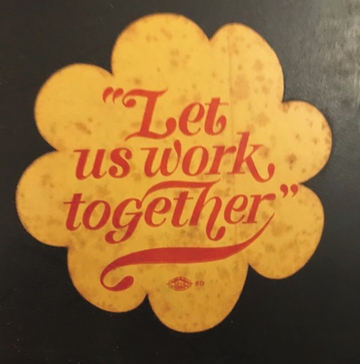
Photo courtesy Alfredo G. Evangelista
Cravalho, who grew up poor, understood the plight of the Filipinos and their values of hard work and education. “He wanted to do for the Filipino community what Burns did for the AJAs,” Constantino believes. Cravalho, he thinks, wanted the Filipino youth to pursue higher education and created scholarships for them.
“I am forever grateful to the Mayor Cravalho who gave me the opportunity that led me to pursue the life of public service, says Bagoyo, who would later serve on the County Council. “This experience and his constant encouragement led me to leave the County and pursue my undergraduate and masters degrees. I can honestly say Mayor Cravalho’s influence is one of the turning points of my educational and professional career and I am forever grateful to be mentored by him.”
“I was told his family was supportive of renaming the entry to the Airport and that settled it for me and the rest of the Maui delegation with Reps. Yamashita and Hashimoto taking the lead in the House and Sen. English in the Senate as a member of Senator Lee’s and Vice-Chair Inouye’s transportation committee,” Keith-Agaran says. “This represents only a small token and perhaps just the first, given Mayor Cravalho’s many accomplishments for the State and County but residents and visitors will see his name when they arrive and leave our island.”
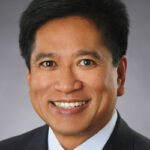 Alfredo G. Evangelista is a graduate of Maui High School (1976), the University of Southern California (B.A. Political Science 1980), and the University of California at Los Angeles School of Law (1983). He is a sole practitioner at Law Offices of Alfredo Evangelista, A Limited Liability Law Company, concentrating in estate planning, business start-up and consultation, nonprofit corporations, and litigation. He has been practicing law for 37 years (since 1983) and returned home in 2010 to be with his family and to marry his high school sweetheart, the former Basilia Tumacder Idica.
Alfredo G. Evangelista is a graduate of Maui High School (1976), the University of Southern California (B.A. Political Science 1980), and the University of California at Los Angeles School of Law (1983). He is a sole practitioner at Law Offices of Alfredo Evangelista, A Limited Liability Law Company, concentrating in estate planning, business start-up and consultation, nonprofit corporations, and litigation. He has been practicing law for 37 years (since 1983) and returned home in 2010 to be with his family and to marry his high school sweetheart, the former Basilia Tumacder Idica.
In the summer of 1977, he worked for the County of Maui—first in the Office of the Mayor and later in the Department of Motor Vehicles. One of the scholarships he received during college was the Mayor Elmer F. Cravalho Scholarship.

